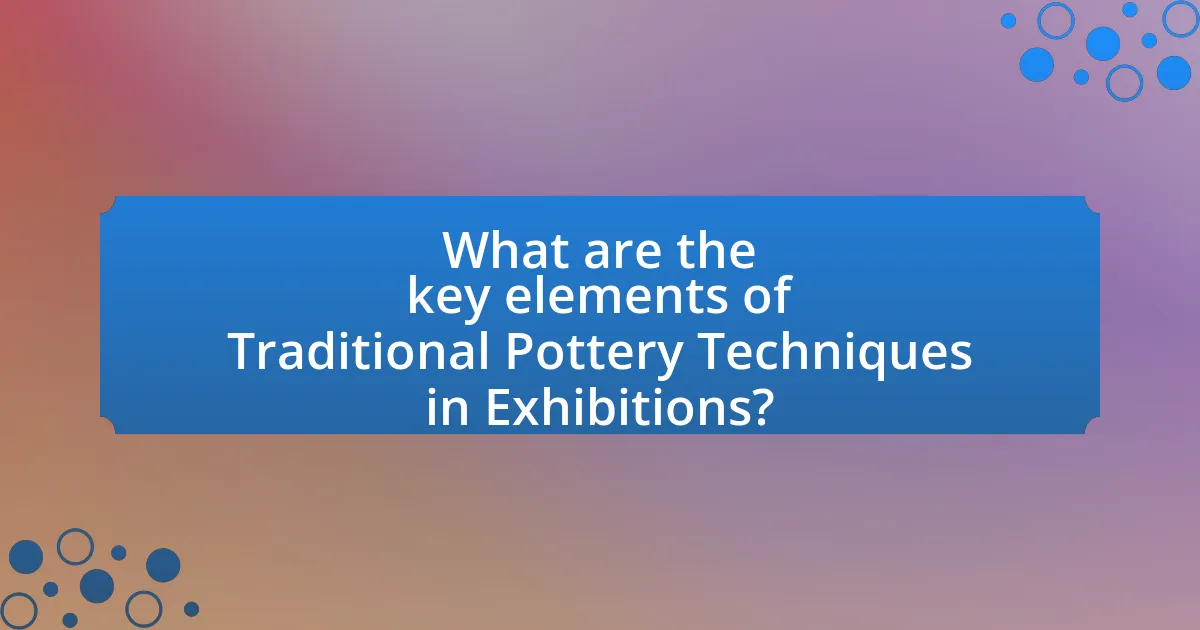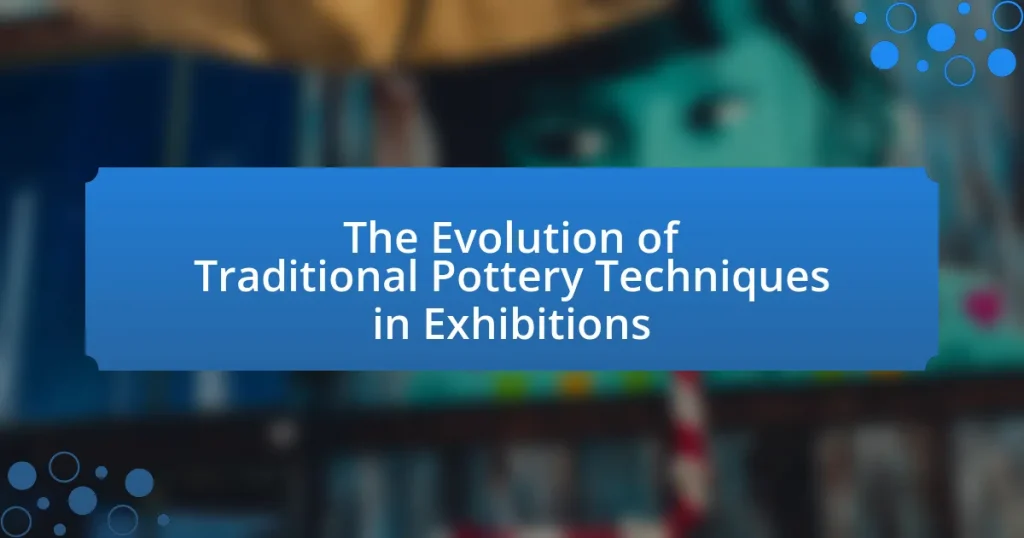The article focuses on the evolution of traditional pottery techniques as showcased in exhibitions. It explores the historical methods used by artisans, including hand-building and wheel-throwing, and how these techniques have transformed over time due to cultural exchanges and technological advancements. The significance of traditional pottery in exhibitions is highlighted, emphasizing its role in preserving cultural heritage and craftsmanship. Additionally, the article discusses the challenges faced by traditional pottery in contemporary contexts, the impact of audience preferences, and the importance of interactive experiences in enhancing visitor engagement with pottery techniques.

What are Traditional Pottery Techniques?
Traditional pottery techniques refer to the methods used by artisans to create ceramic objects, often passed down through generations. These techniques include hand-building methods such as coiling, pinching, and slab construction, as well as wheel-throwing, where clay is shaped on a potter’s wheel. Additionally, traditional glazing and firing techniques, such as pit firing and wood firing, are employed to finish the pottery. Historical evidence shows that these methods have been utilized for thousands of years across various cultures, highlighting their significance in the evolution of pottery craftsmanship.
How have Traditional Pottery Techniques evolved over time?
Traditional pottery techniques have evolved significantly over time, transitioning from purely functional creations to artistic expressions influenced by cultural exchanges and technological advancements. Initially, pottery was primarily utilitarian, with ancient civilizations using hand-building methods and natural materials like clay and plant fibers. As societies advanced, techniques such as wheel-throwing emerged around 3500 BCE in Mesopotamia, allowing for more uniform shapes and sizes.
The introduction of glazing techniques during the Han Dynasty in China (206 BCE – 220 CE) further transformed pottery, enhancing both aesthetics and durability. The global trade routes established during the Middle Ages facilitated the exchange of ideas and materials, leading to regional variations in styles and techniques, such as the intricate designs of Islamic pottery and the vibrant colors of Mexican Talavera.
In contemporary times, traditional pottery techniques have been preserved and adapted, with artists incorporating modern tools and methods while maintaining cultural significance. Exhibitions often showcase this evolution, highlighting the blend of ancient practices with innovative approaches, thus reflecting the ongoing dialogue between tradition and modernity in pottery.
What historical influences have shaped Traditional Pottery Techniques?
Traditional pottery techniques have been shaped by various historical influences, including cultural exchanges, technological advancements, and regional resources. For instance, the introduction of the potter’s wheel in Mesopotamia around 3500 BCE revolutionized pottery production, allowing for more uniform shapes and faster creation. Additionally, the Silk Road facilitated the exchange of pottery styles and techniques between East and West, influencing designs and methods across cultures. The availability of local clay types and firing techniques also played a crucial role, as seen in the distinct pottery styles of different regions, such as the red clay of the American Southwest or the stoneware of Northern Europe. These historical factors collectively contributed to the diversity and evolution of traditional pottery techniques observed in various exhibitions today.
How do cultural variations impact Traditional Pottery Techniques?
Cultural variations significantly impact traditional pottery techniques by influencing the materials, designs, and methods used in pottery creation. For instance, indigenous cultures often utilize locally sourced clay and natural pigments, which reflect their environment and traditions. In Japan, the practice of Raku pottery emphasizes spontaneity and the aesthetic of imperfection, showcasing cultural values of simplicity and nature. Conversely, in Mediterranean cultures, intricate glazing techniques and vibrant colors are prevalent, highlighting a different set of aesthetic preferences and historical influences. These variations not only shape the physical characteristics of the pottery but also convey cultural narratives and social practices, as seen in the distinct pottery styles of the Pueblo peoples in the American Southwest, which incorporate symbolic motifs and storytelling elements.
Why are Traditional Pottery Techniques significant in exhibitions?
Traditional pottery techniques are significant in exhibitions because they showcase cultural heritage and craftsmanship. These techniques often reflect the historical context and social practices of the communities that produce them, providing insight into their traditions and values. For instance, the use of specific clay types and firing methods can indicate regional identities and historical trade routes. Exhibitions featuring traditional pottery techniques not only preserve these art forms but also educate audiences about their importance, as evidenced by the inclusion of such works in major cultural institutions like the Smithsonian, which emphasizes the role of traditional crafts in understanding human history.
What role do exhibitions play in preserving Traditional Pottery Techniques?
Exhibitions play a crucial role in preserving Traditional Pottery Techniques by providing a platform for artisans to showcase their skills and for audiences to engage with the cultural heritage. These events facilitate knowledge transfer between generations, as experienced potters demonstrate techniques to younger artisans, ensuring that traditional methods are not lost. For instance, exhibitions often include workshops and live demonstrations, which have been shown to increase interest and participation in traditional pottery practices, as evidenced by the rise in attendance at cultural festivals focused on pottery. Furthermore, exhibitions serve as a repository for historical artifacts, allowing for the documentation and study of various techniques, thus reinforcing their significance in cultural identity.
How do exhibitions showcase the evolution of Traditional Pottery Techniques?
Exhibitions showcase the evolution of traditional pottery techniques by displaying artifacts that represent various historical periods and cultural practices. These exhibitions often include a chronological arrangement of pottery pieces, illustrating the progression of materials, styles, and methods used by artisans over time. For instance, an exhibition may feature ancient clay pots alongside contemporary works, highlighting advancements in glazing techniques and firing processes. Additionally, educational panels and interactive demonstrations provide context, explaining the significance of each technique and its cultural relevance. This approach not only preserves the history of pottery but also engages visitors in understanding the craftsmanship involved, as seen in exhibitions like “The Art of Clay” at the Smithsonian, which emphasizes the transformation of pottery from functional objects to artistic expressions.

What are the key elements of Traditional Pottery Techniques in Exhibitions?
The key elements of Traditional Pottery Techniques in Exhibitions include craftsmanship, cultural significance, and material authenticity. Craftsmanship is demonstrated through the skillful hand-building and wheel-throwing methods that artisans employ, reflecting centuries of tradition. Cultural significance is highlighted by the stories and practices associated with specific pottery styles, which often represent the identity and heritage of communities. Material authenticity is crucial, as traditional pottery relies on locally sourced clays and natural glazes, ensuring that the pieces are true to their origins. These elements collectively enhance the educational and aesthetic value of pottery exhibitions, allowing visitors to appreciate the depth of traditional techniques.
How do artisans demonstrate Traditional Pottery Techniques in exhibitions?
Artisans demonstrate Traditional Pottery Techniques in exhibitions by engaging in live demonstrations, showcasing the entire pottery-making process from shaping clay to firing. These demonstrations often include techniques such as hand-building, wheel-throwing, and glazing, allowing visitors to observe the craftsmanship and skill involved. For instance, artisans may use traditional tools and methods that have been passed down through generations, highlighting the cultural significance and historical context of their work. This hands-on approach not only educates the audience about the intricacies of pottery but also preserves and promotes the heritage of traditional techniques.
What tools and materials are commonly used in Traditional Pottery Techniques?
Traditional pottery techniques commonly utilize tools such as potter’s wheels, hand tools, and kilns, along with materials like clay, glazes, and slips. Potter’s wheels enable artisans to shape clay into symmetrical forms, while hand tools assist in detailing and finishing pieces. Kilns are essential for firing pottery to achieve durability and desired finishes. Clay serves as the primary medium, with various types like earthenware, stoneware, and porcelain being used based on the desired characteristics of the final product. Glazes provide color and a protective coating, while slips, which are liquid clay mixtures, can be used for decoration or as a bonding agent. These tools and materials have been foundational in the practice of pottery for centuries, reflecting the craftsmanship and cultural significance of traditional pottery techniques.
How do artisans incorporate modern influences into Traditional Pottery Techniques?
Artisans incorporate modern influences into traditional pottery techniques by integrating contemporary design elements, innovative materials, and advanced technology. For instance, many artisans now use digital tools for design and precision, allowing for intricate patterns that were difficult to achieve with traditional methods. Additionally, the use of non-traditional glazes and finishes, which may include eco-friendly or synthetic materials, reflects modern aesthetic preferences while maintaining the foundational techniques of pottery. This blending of old and new not only revitalizes traditional practices but also appeals to contemporary markets, as seen in exhibitions showcasing works that fuse cultural heritage with modern artistry.
What challenges do Traditional Pottery Techniques face in contemporary exhibitions?
Traditional pottery techniques face several challenges in contemporary exhibitions, primarily due to the clash between traditional craftsmanship and modern presentation standards. These challenges include the difficulty in maintaining authenticity while appealing to contemporary audiences, as many exhibitions prioritize innovative designs and multimedia presentations over traditional methods. Additionally, the limited understanding of the cultural significance of traditional pottery among modern viewers can lead to a lack of appreciation for the techniques used, resulting in underrepresentation in exhibitions. Furthermore, the economic pressures on artisans to produce commercially viable pieces can compromise the integrity of traditional methods, as they may opt for faster, less labor-intensive techniques to meet market demands.
How do changing audience preferences affect the presentation of Traditional Pottery Techniques?
Changing audience preferences significantly influence the presentation of Traditional Pottery Techniques by prompting curators and artisans to adapt their displays to align with contemporary tastes and values. For instance, as audiences increasingly prioritize sustainability and cultural authenticity, exhibitions may showcase eco-friendly materials and traditional methods that emphasize craftsmanship. This shift is evidenced by the rise in popularity of exhibitions that highlight the stories behind the pottery, such as the “Crafting the Future” exhibit at the Museum of Contemporary Art, which featured artisans who incorporate local materials and ancestral techniques, attracting a diverse audience interested in heritage and sustainability. Consequently, the evolving preferences of audiences drive a transformation in how traditional pottery is presented, ensuring relevance and engagement in modern contexts.
What are the sustainability concerns related to Traditional Pottery Techniques?
Sustainability concerns related to traditional pottery techniques include the depletion of natural resources, environmental degradation, and energy consumption. Traditional pottery often relies on clay and other raw materials that can be over-extracted, leading to habitat destruction and loss of biodiversity. Additionally, the firing process typically requires significant energy, often sourced from non-renewable fuels, contributing to carbon emissions. Studies indicate that the environmental impact of pottery production can be mitigated through the use of sustainable materials and energy-efficient practices, highlighting the importance of integrating eco-friendly methods into traditional techniques.

How can audiences engage with Traditional Pottery Techniques in exhibitions?
Audiences can engage with Traditional Pottery Techniques in exhibitions through interactive workshops, demonstrations, and hands-on activities. These formats allow visitors to learn directly from artisans, gaining insights into the historical and cultural significance of pottery techniques. For instance, exhibitions often feature live demonstrations where skilled potters showcase wheel-throwing or hand-building methods, enabling attendees to observe the intricacies involved. Additionally, workshops may provide participants with the opportunity to create their own pottery pieces, fostering a deeper appreciation for the craftsmanship and effort required in traditional pottery. Such engagement not only enhances the educational experience but also connects audiences to the rich heritage of pottery-making practices.
What interactive experiences are available for visitors at pottery exhibitions?
Visitors at pottery exhibitions can engage in hands-on workshops where they can create their own pottery pieces using traditional techniques. These workshops often include guidance from skilled artisans who demonstrate methods such as wheel throwing and hand-building. Additionally, many exhibitions feature interactive displays that allow visitors to explore the history and evolution of pottery through touchable artifacts and multimedia presentations. Some exhibitions also offer live demonstrations, enabling attendees to observe the pottery-making process in real-time, enhancing their understanding of the craft.
How can visitors learn about the history and techniques of pottery through exhibitions?
Visitors can learn about the history and techniques of pottery through exhibitions by engaging with curated displays that showcase artifacts, tools, and techniques used throughout different historical periods. These exhibitions often include detailed descriptions and contextual information that explain the evolution of pottery styles, materials, and methods, allowing visitors to understand the cultural significance and technological advancements in pottery. For instance, exhibitions may feature ancient pottery from various civilizations, highlighting how local resources influenced design and function, thus providing a comprehensive view of pottery’s historical journey.
What workshops or demonstrations can enhance visitor understanding of Traditional Pottery Techniques?
Workshops and demonstrations that can enhance visitor understanding of Traditional Pottery Techniques include hands-on pottery-making sessions, wheel-throwing demonstrations, and glazing workshops. These interactive experiences allow visitors to engage directly with the materials and processes used in traditional pottery, fostering a deeper appreciation for the craft. For instance, hands-on sessions enable participants to create their own pieces, while wheel-throwing demonstrations showcase the skill involved in shaping clay on a potter’s wheel. Additionally, glazing workshops teach the importance of surface decoration and finishing techniques, which are crucial in traditional pottery. Such activities not only provide practical knowledge but also connect visitors with the cultural significance and historical context of pottery-making practices.
What best practices should be followed when organizing pottery exhibitions?
To effectively organize pottery exhibitions, it is essential to establish a clear theme that reflects the evolution of traditional pottery techniques. This thematic focus helps in curating relevant pieces that tell a cohesive story, enhancing visitor engagement. Additionally, selecting an appropriate venue that accommodates the size and nature of the exhibition is crucial; spaces with good lighting and accessibility can significantly improve the viewing experience.
Moreover, promoting the exhibition through targeted marketing strategies, such as social media campaigns and partnerships with local art organizations, can increase attendance and awareness. Engaging with the pottery community, including artists and collectors, fosters collaboration and can lead to a more diverse collection of works on display.
Finally, providing educational materials, such as brochures or guided tours, can enrich the visitor experience by offering insights into the historical context and techniques of the pottery showcased. These practices collectively contribute to a successful pottery exhibition that honors the craft’s evolution.
How can curators effectively highlight the evolution of Traditional Pottery Techniques?
Curators can effectively highlight the evolution of Traditional Pottery Techniques by organizing exhibitions that showcase chronological displays of pottery artifacts, illustrating the progression of styles, materials, and methods over time. This approach allows visitors to visually and contextually understand the historical context and cultural significance of each technique. For instance, curators can include detailed labels that explain the technological advancements, such as the transition from hand-building to wheel-throwing, and the introduction of new glazing techniques during specific historical periods. Additionally, interactive elements, such as live demonstrations or workshops, can engage audiences and provide hands-on experiences that reinforce the learning of traditional methods. By incorporating multimedia presentations that feature interviews with artisans and historians, curators can further enrich the narrative of pottery’s evolution, making the exhibition both informative and engaging.
What strategies can be employed to attract diverse audiences to pottery exhibitions?
To attract diverse audiences to pottery exhibitions, organizers can implement targeted outreach strategies, such as community engagement initiatives and partnerships with local cultural organizations. Engaging with various community groups through workshops and educational programs can foster interest and participation, as evidenced by the success of similar initiatives in art exhibitions that increased attendance by 30% among underrepresented demographics. Additionally, utilizing social media campaigns that highlight diverse artists and their stories can broaden appeal, as research shows that inclusive marketing increases audience engagement by 50%.


